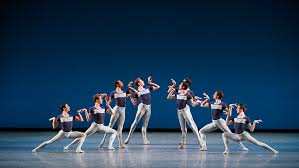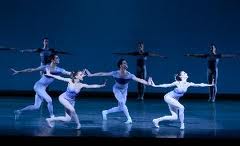Note: This review marks the continuation of a series dedicated to showcasing the best student writing from the Dance History course I teach at The Juilliard School.
By Alexandra Hutt
George Balanchine is famously credited with saying that “ballet is woman.” This idea is boldly apparent in his Kammermusik No. 2, which premiered on New York City Ballet in January 1978, and more recently was performed by the company as part of their 2014 winter season.
Throughout the work, seen January 22, Balanchine demonstrates his knowledge of classical ballet, stemming from his training in Russia as a child. Yet he also takes codified ballet steps and pushes them to their limits, demanding hyper-musicality, and infusing ornate, mannerist detail into both the dancers’ gestures and footwork. Alastair Macaulay of the New York Times described Kammermusik as “classicism dotted with deliberate stylistic perversions.” It is those “stylistic perversions” that exemplify Balanchine’s advancement of ballet, and reveal a more nuanced expression of his statement, “ballet is woman”; in that woman embodies Nature—and she is a force to be reckoned with.
Balanchine creates the woman as nature comparison from the beginning of his work. When the curtain rises, the principal women (Rebecca Krohn and Abi Stafford) stand apart form a corps of eight men. When the men begin moving with flexed hands and feet, they look like little spiders. Their movement deepens the intriguing musical counterpoint, ominousness and whimsy that lies at the heart of Hindemith’s score, conducted by Andrew Sills. In the more whimsical moments of Hindemith’s Kammermusik No. 2, the same men become prancing ponies, dancing in canon with a certain earnest and feminine quality. Then, they return to their insect-likeness and weave in and out of one another, as a group of ants might, when following a particularly scrumptious set of crumbs. Is Balanchine making fun of them? At the very least, he does it to elevate the roles of the women.
Though both the men and women in Kammermusik seem to represent four legged creatures, it becomes clear that the female creatures are of a higher taxonomic order, such as tarantulas, with their the forbiddingly long legs and extensions of them. Like their male counterparts, they skitter across the stage, but because they do so in pointe shows they devour space, while retaining an elegance that the opposite sex does not possess in this movement. Not even the choreography for the principal men (Amar Ramasar and Jared Angle) evoke the languid quality that the tarantula-women embody. The women’s sensual style gives their dancing dimension and depth. It’s a feminine kind of power. In one particular sequence, the women seem to transform into another force of nature—massive waves. With oceanic power they chase their partners off of the stage.
In Kammermusik, the women rule unapologetically. They encompass aspects of the animal kingdom that can be overlooked, such as the illusive cunning of the tigress, who will kill (or be killed) before giving up her territory. Balanchine shows the audience that when he says that ballet is woman, he isn’t referring to the tragic victims in ballet narratives of the 18th and 19th centuries. In this work, his female dancers represents a strong 20th century vision of women who aren’t afraid of their own strength and power.
**
Alexandra Hutt is originally from Denver, Colorado. She studied dance at International Ballet School, and received additional training and mentorship from Robert Sher-Machherndl of Lemon Sponge Cake Contemporary Ballet. She is thrilled to be studying at Juilliard, and looks forward to continuing her education in New York City!



Fall for Dance Festival: Recapping Program 1, 2 and 5
Wednesday, October 17th, 2012By Rachel Straus
The seventh annual Fall For Dance Festival came to a meaty close on October 13. Program five at New York’s City Center trafficked in high testosterone, thanks to China’s LPD-Laboratory Dance Project’s No Comment (2002) and Yaron Lifschitz’s Circa (2009), which is also the name of the Australian acrobatic troupe. In both works the body was treated like a battering ram.
Circa by Justin Nicholas Atmosphere Photography
In Circa, the performers used not only their fellow artists’ thighs and shoulders, but also their faces, as launching pads for balancing in midair and jettisoning across the space like Evel Knievel. In No Comment, the men continually fell to the floor, as though blown down by an invisible hammer. As a finale, they stripped to their waists to reveal their glistening muscular torsos. Like fight club winners, they took their bows. But their message—sex objects who pulverize themselves are cool—confounded me.
Visions of aggression and angst trumped visions of cooperation and kindliness in the three FFD programs of 12 dances from 12 international and national-based companies seen on September 28 and 30, and October 13. Perhaps the programming, spearheaded by artistic advisor Stanford Makishi, not only represented his personal preferences, but also reflected the times. The majority of the works were made in the past four years, and only two dated before 2002. This decade hasn’t been an easy ride; the dances reflects that.
The festival’s first program ended with Martha Graham’s Chronicle, which was made in response to rising European fascism before World War II. The first section of Graham’s 1936 work surprisingly echoed the last work in the festival: Deseo Y Conciencia (2011). In Deseo, flamenco choreographer-performer Maria Pagés donned a red costume that transformed into a shroud. Likewise, the gargantuan red underskirt worn by Blakeley White-Mcguire in Chronicle possessed the same import. Both women became symbols of mourning, evoking through their blood-red cloaks a fraught world.
Maria Pages. Photo by David Ruano
Blakeley White-McGuire. Photo by Michele Ballantini
The two most ambitious works, of the 12 viewed, were Pam Tamowitz’s Fortune (2011) and Christopher Wheeldon’s Five Movements, Three Repeats (2012). Both tendered subtlety, nuance and mystery. (Full disclosure: Fortune was choreographed on the Juilliard School dancers and I work at Juilliard.) In Fortune, Tamowitz set 21 dancers, costumed in hot pink and red unitards, against a field of greenish yellow. Here was a happy Mark Rothko painting. Though Tamowitz’s movement vocabulary is clearly inspired by Merce Cunningham’s, she doesn’t ignore the music as was Cunningham’s way. Tamowitz’s sharply sculptural patterning, full of pregnant pauses, reflected Charles Wuorinen’s stop and go Fortune (performed by a quartet Juilliard School musicians). In response to Wuorinen’s abrupt shifts in sounds, which instantly dissolve as though they never happened, Tamowitz evokes mini narratives, some absurd, others resonant of a city life, where pedestrians walk with laser-eye certainty.
Juilliard Dancers in "Fortune." Photo by Rosalie O'Connor
Also of note was Christopher Wheeldon’s Five Movements, Three Repeats, which was made for Fangi-Yi Sheu & Artists. Sheu, a former Graham dancer born and trained in Taiwan, is now based in New York. She is one of the great performers of our time. Her guests were none other than Wheeldon’s former colleagues at New York City Ballet: Tyler Angle, Craig Hall and Wendy Whelan. To a recording of Max Richter’sMEMORYHOUSE and Otis Clyde’s The Bitter Earth/On the Nature of Daylight, Wheeldon didn’t treat Sheu as some modern dance oddity among the City Ballet dancers.
At the beginning of every other section of Five Movements, Three Repeats, Sheu undulated her spine like a fern seeking light. Her pliable torso work was best picked up in Hall’s simultanesously-occurring solo that spiraled into the floor. Later on, Sheu and Hall folded their limbs into each other. Their duet featured a melding of their bodies, and organically blended central aspects of their different technical training (Sheu’s focuses on weight, Hall’s on ethereality).
Ms. Sheu and Mr. Hall. Photo by Erin Baiano
Though Sheu’s legwork is akin to the arrow-like esthetic favored by ballet choreographers, Wheeldon didn’t devolve to his usual histrionics: over-choreographing women’s leg extensions in the pas de deux. Consequently, Sheu did not become a human gumby. Instead, she partnered Hall’s weight as much as Hall partnered her’s. Wheeldon’s venture into making work for a modern-trained dancer is heartily welcome. The task seems to stretch him instead of over-stretching his female collaborators.
Tags:Blakeley White-Mcguire, Charles Wuorinen, Christopher Wheeldon, Chronicle, Circa, Craig Hall, Deseo Y Conciencia, Evel Knievel, Fall for Dance Festival, Fang Yi-Sheu, Five Movements Three Repeats, Fortune, LPD-Laboratory Dance Project, Maria Pages, Martha Graham, Max Richter, Memoryhouse, Merce Cunningham, No Comment, Otis Clyde, Pam Tamowitz, Stanford Makishi, The Bitter Earth/On the Nature of Daylight, The Juilliard School, Tyler Angle, Wendy Whelan, Yaron Lifschitz
Posted in The Torn Tutu | Comments Closed